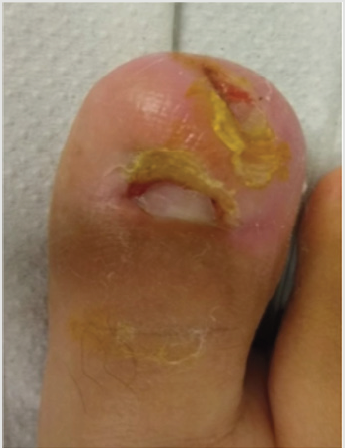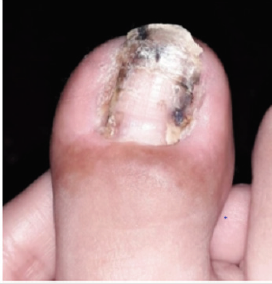Introduction
A 14-years-old girl presented to Paediatric clinic after an aggressive recurrence of ingrown toenail 6 months ago treated with proximolateral matrix partial excision. In this case an inflammation and proliferation of granulation tissue, with a lush growth tissue covering the growing nail was observed [1] (Figure 1). Under regional anesthesia, a wide local excision of the soft tissue and a new proximolateral matrix partial excision were required. After 6 months of follow-up the patient remains asymptomatic (Figure 2). The onychocryptosis in the pediatric population is a highly prevalent pathology. The disproportion between the matrix and the nail plate size, obesity, diabetes mellitus and hyperhidrosis have been described as risk factors. The use of narrow shoes, poor nail cutting technique, poor hygiene and local plantar injuries playing sports such as football could be a trigger for the onychocryptosis development [2,3]. In mild forms of onychocryptosis, they are treated with hot water and salt washes for 15 or 20 minutes every 12 hours, topical antiseptics and oral anti-inflammatories [4]. The surgical approach is the procedure of choice in advanced stages with two different techniques, onychectomy with mastoidectomy by chemical abrasion (CA) or mechanical abrasion (MA). The use of MA has lower complication rate than CA, including local infection and recurrence (9% MA in front of 33% CA) in pediatrics5. In case of recurrences, the best surgical approach is controversial [5].
Figure 1: Aggressive in growing toenails recurrence with growth of soft tissue covering the growing nail.
Figure 2: After 6 months since the local excision of the soft tissue and proximolateral matrix partial excision, no recurrence is observed.
References
- Rounding C, Bloomfield S (2005) Surgical treatments for ingrowing toenails. Cochrane Database Syst Rev 18(2): 1-21.
- Mousavi S, Khoshnevice J (2012) A new surgical technique for ingrown toenail ISRN Surg pp. 22-27.
- Heidelbaugh JJ, Lee H (2009) Management of ingrown toenails. Am Fam Physician 79(4): 303-308.
- Gioseffi ML, Giachetti A, Sánchez L (2010) Onichocryptosis in pediatrics: conservative treatment and spiculectomy. Arch Argent Pediatr 108(3): 244-246.
- Leganés C, Ezzeddine M, Giné C, Laín A, Lopez M (2020) Partial onychectomy whit matricectomy by mechanical abrasion versus phenolization in the treatment of incarnate nail. Acta Pediatrica 78: 3-4.

 Case Report
Case Report

